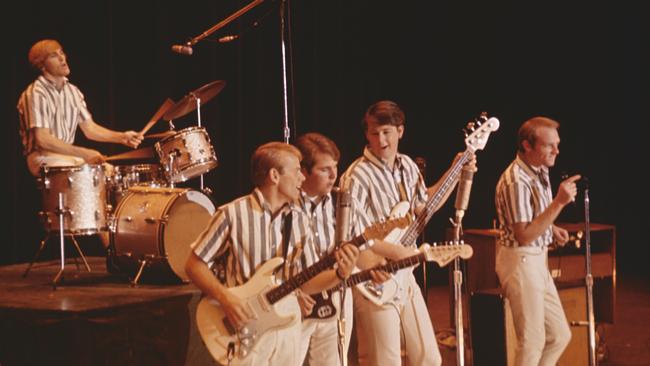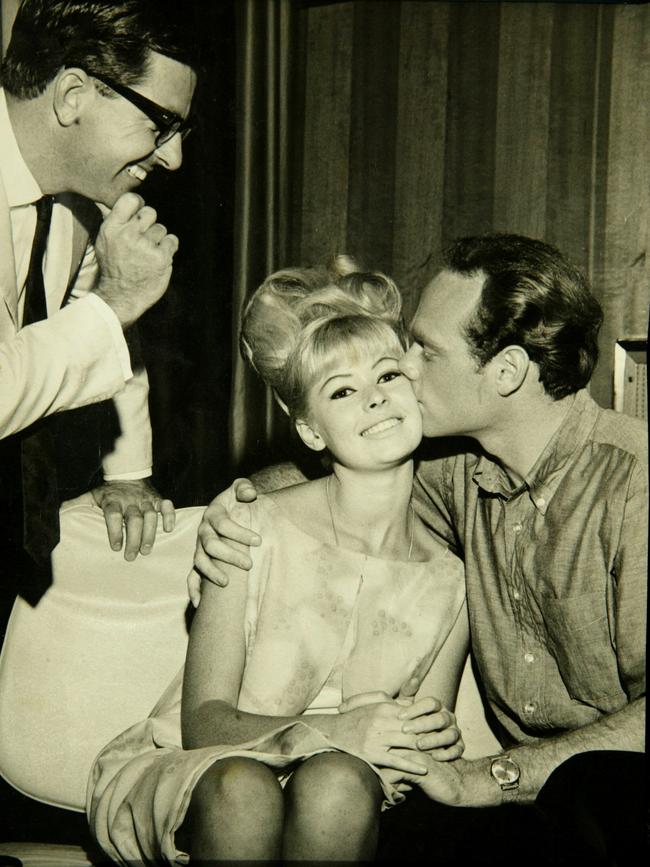A sunny look at The Beach Boys as band members recall first tour down under
Troy Bramston interviews The Beach Boys’ Mike Love and Al Jardine about a new documentary on the legendary band – and their distinct memories of summer Down Under in 1964.

The Beach Boys had three top ten studio albums by the time they arrived in Australia for their first national tour in January 1964 and their live album released later that year, Beach Boys Concert, would rocket to No.1 on the US charts.
Mike Love, lead vocalist and songwriter, remembers the Australian tour. When they arrived in Sydney, they were met by a frenzy of hundreds of mostly teenage fans who rushed for photos and autographs. They spent several days doing promotion and enjoying the harbour city before performing.
“Roy Orbison was on the show with us down there and a group called The Joy Boys, and they taught us some bad things,” Love, 83, tells Review. “We had a great time though. And yeah, I mean, to be standing in the wings listening to Roy Orbison at that point in time was monumental. It was phenomenal.”
The band has a unique relationship with Australia with several No.1 singles, including Good Vibrations (1966) and Do It Again (1968), both of which Love co-wrote. He reminds me that a quarter-of-a-century after that first tour outside the US, another song he co-wrote, Kokomo (1988), spent eight weeks at No.1 in Australia.
Love has another distinct memory of that summer of 1964. “I went to the Sydney Rowing Club and drank a Reschs dinner ale down in one gulp and people applauded me for it,” he recalls. “I wanted to show my appreciation for the beverage product of Australia.”

Al Jardine, guitarist and vocalist, also has fond memories of the Surfside ’64 tour alongside Orbison, The Surfaris, Paul & Paula, and local legends The Joy Boys, in Brisbane, Sydney, Adelaide, Melbourne and Hobart. They often played two or three shows a night with wild crowds of thousands singing, dancing, clapping and screaming.
“I loved it,” Jardine, 81, tells Review. “I loved listening to Roy sing. I loved being his opening act. That was just a terrific experience. That was my first time Down Under and I’ll never forget it. It was just a marvellous experience.”
In 1968, Jardine was lead vocalist on a cover of the 1940s Huddie Ledbetter blues single, Cottonfields. The song did not chart well in the US but was another hit in Australia, peaking at No.1 on the local charts
“Cottonfields was great,” Jardine recalls. “It did work very well all around the world, except in the US of all things. Folk music wasn’t happening at that time, I guess. Or Beach Boy music for that matter. But I was glad to see that it was appreciated down there.”
The story of The Beach Boys is told in a terrific new documentary that includes new and archival interviews with band members alongside historic film, photos and memorabilia. It documents their extraordinary musical progression and influence on other bands, the rollercoaster of relationships, and later legal disputes.
The Beach Boys, comprising Wilson brothers Brian, Dennis and Carl, with cousin Love and school friend Jardine, began performing and recording in California in 1961. While growing up they had sung vocal harmonies together and began adding simple lyrics about the surf, the sun, cars, parties, love and having fun.
They sold a summer lifestyle and mindset that transported the listener to another place, shifting a surf music culture that had been largely instrumental. While they grew up in California and absorbed the culture, Dennis, was the only real surfer in the group. Yet on their first album cover, they wore blue plaid Pendleton wool shirts, the clothing of choice for surfers.
They would sell over 100 million records, with 37 songs in the US top 40 — more than any other rock group — and help define the music of the 1960s with iconic songs such as Surfin’ Safari (1962), Surfin’ USA (1963), Surfer Girl (1963), Fun, Fun, Fun (1964), I Get Around (1964), Help Me, Rhonda (1965), California Girls (1965) and the impromptu cover classic, Barbara Ann (1965).
1966 was a turning point for the band with the release of Pet Sounds, often hailed as the greatest record ever made. Nobody had heard anything like it before. With Brian’s songwriting and arrangements, a variety of musical styles and instruments, the band became more inventive and creative, setting a new standard. The record included Wouldn’t It Be Nice, Sloop John B and God Only Knows.
The Beatles arrived for their first tour of Australia six months after The Beach Boys in June 1964. A friendly rivalry had begun between the American and British groups, with both on the Capitol Records label and influencing each other.
Without The Beatles’ Rubber Soul (December 1965) there would be no Pet Sounds (May 1966) which in turn inspired The Beatles to make Revolver (August 1966). The release of the single Good Vibrations (October 1966) showed The Beach Boys to be at their most imaginative, and it soared to No.1 in the US, Britain and Australia. And without that, The Beatles would not have been motivated to make Sgt. Pepper’s Lonely Hearts Club Band (May 1967).
“It ignited their passion to make better music,” Jardine says of The Beatles. “Brian did appreciate their music a lot and I’m sure that it made an impression on him.” At the time, Jardine thought they should do a concert together.
It was Jardine’s mother, Virginia, who loaned them $300 to rent instruments in 1961. They were all teenagers at school at the time and had to teach themselves how to play most of the instruments, write music and sing lyrics together.
“We were struggling to be heard and to play for people and to record but we had no instruments,” Jardine recalls. “When my mum pitched in the rest of the money we needed — it was a month’s wages for her — we were very grateful.”
Jardine left the band in 1962 to attend college and rejoined in 1963. David Marks played on four albums. Bruce Johnston joined the band in 1965 after Brian Wilson gave up touring to focus on songwriting and producing. (Glen Campbell filled in for Wilson on tour in 1964-65.) Wilson had suffered a nervous breakdown and continued to struggle with his mental health. He would work with The Wrecking Crew to lay down instrumental tracks while the band was touring and they would add vocals later.
Love co-wrote many of the band’s songs with Wilson but resented that credit was not always shared. It led to litigation between the two, just one of a slew of legal fights between band members, family and record companies. But Love says that is now resolved and he is proud of the collaborations with his bandmate. He continues to tour as The Beach Boys but without the other original band members.
“We loved the music (and) we loved harmonising together,” Love explains. “(Brian) was gifted at sitting down at the piano and structuring those harmonies and chord progressions, and depending on the tempo, we would write a song. We had a great rapport.”
Murry Wilson, father to Brian, Dennis and Carl, was essential to the success of The Beach Boys. He had been a songwriter, producer and manager, and secured the band a contract with Capitol Records. But there was a dark side. Murry could be belligerent, aggressive and physically abusive. He was eventually dismissed as their manager. He later sold the band’s music without telling them in 1969. “He was a good promoter,” Love says of his uncle. “He got us known on the radio and all over the place through his efforts. But he was insufferable to deal with. We knew what we wanted to do, but he told us we didn’t know what we were doing. And, so, Brian and I had to fire him.”
Do It Again (1968) was the last hit song before Kokomo but the band had enduring success with compilation and live albums. The release of Endless Summer (1974) with their early songs led to a revival and was No.1 in the US. The Summer Dreams album (1990) was a top ten hit in Australia.
The generational appeal of The Beach Boys has not waned. The first record that I owned was The Beach Boys (1985), which also featured Ringo Starr and Stevie Wonder.
“The songwriting, certainly, is the basis for the appeal,” Jardine says. “The songs have a wonderful lyrical basis that reaches out to every generation. It’s just a wonderful thing that Brian and Mike were able to write some really great songs together.”
In the documentary, Brian, Mike, Al, Bruce and David — Dennis died in 1983 and Carl died in 1988 — reunite at Malibu’s Paradise Cove, the setting for their first album cover, Surfin’ Safari, in 1962. More than six decades later, their music is still playing.
“We were so close and we had such a bond with so much humour, so much love of music together and, you know, that showed up in our music,” Love says.
The Beach Boys screens on Disney+.


To join the conversation, please log in. Don't have an account? Register
Join the conversation, you are commenting as Logout